Strategic Change Management Plan for Apple Inc. - BTEC L7 Diploma
VerifiedAdded on 2023/06/10
|22
|6228
|162
Report
AI Summary
This report provides a comprehensive analysis of implementing a change management strategy within Apple Inc., addressing issues related to employee lawsuits and morale. It explores various change management models, including Lewin's Change Management Model, the McKinsey 7-S Model, and Kotler's Change Management Theory, and assesses their relevance to Apple's specific challenges. The report examines the need for change, resource implications, and the development of systems to involve stakeholders. It proposes strategies to manage resistance and details a plan for implementing a change management model to improve employee relations and overall organizational operations. The document, contributed by a student, is available on Desklib, a platform offering study tools and assignment solutions.

Running head: CHANGE MANAGEMENT PLAN FOR APPLE INC.
CHANGE MANAGEMENT PLAN FOR APPLE INC.
Name of the Student
Name of the University
Author Note
CHANGE MANAGEMENT PLAN FOR APPLE INC.
Name of the Student
Name of the University
Author Note
Paraphrase This Document
Need a fresh take? Get an instant paraphrase of this document with our AI Paraphraser
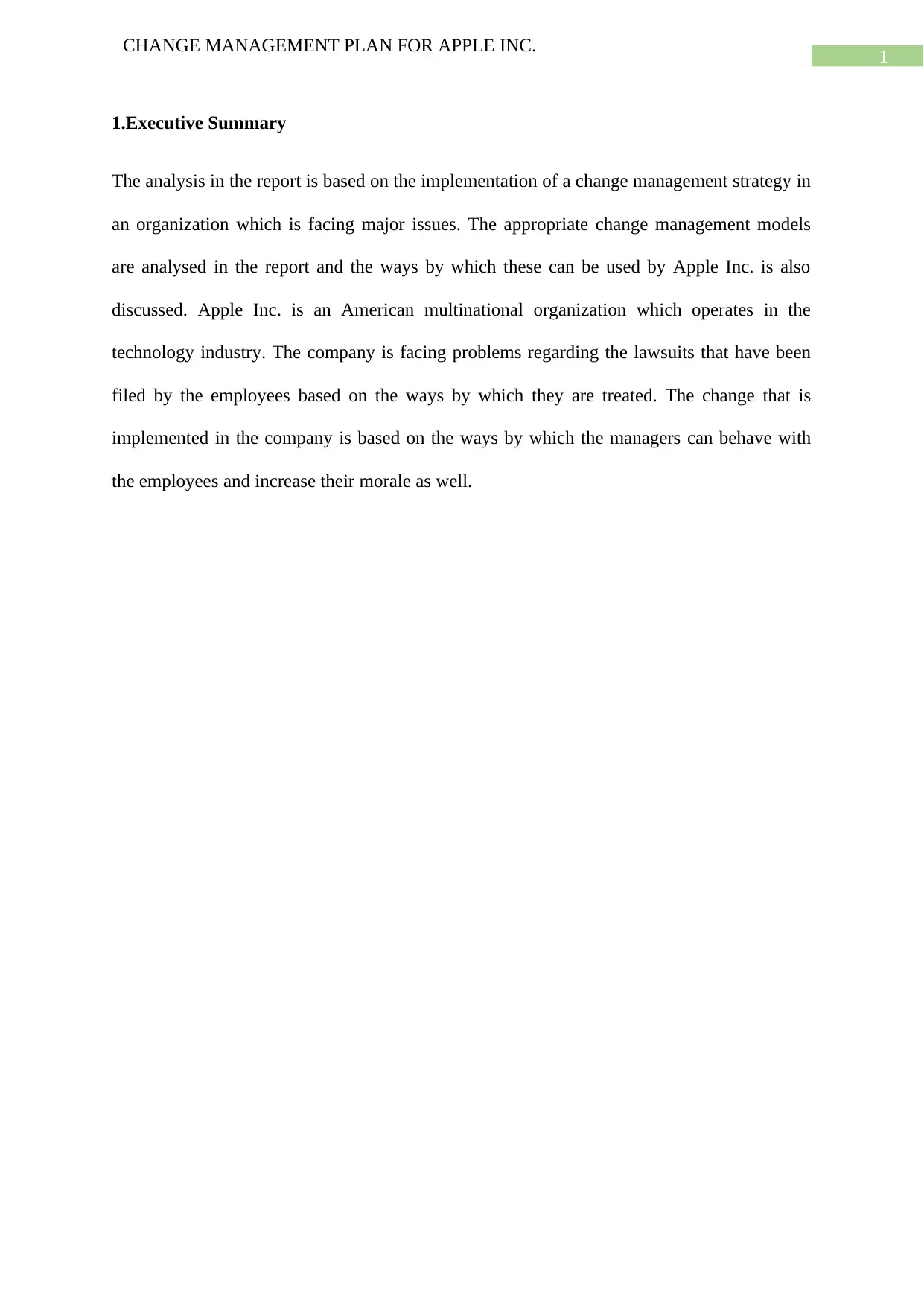
1
CHANGE MANAGEMENT PLAN FOR APPLE INC.
1.Executive Summary
The analysis in the report is based on the implementation of a change management strategy in
an organization which is facing major issues. The appropriate change management models
are analysed in the report and the ways by which these can be used by Apple Inc. is also
discussed. Apple Inc. is an American multinational organization which operates in the
technology industry. The company is facing problems regarding the lawsuits that have been
filed by the employees based on the ways by which they are treated. The change that is
implemented in the company is based on the ways by which the managers can behave with
the employees and increase their morale as well.
CHANGE MANAGEMENT PLAN FOR APPLE INC.
1.Executive Summary
The analysis in the report is based on the implementation of a change management strategy in
an organization which is facing major issues. The appropriate change management models
are analysed in the report and the ways by which these can be used by Apple Inc. is also
discussed. Apple Inc. is an American multinational organization which operates in the
technology industry. The company is facing problems regarding the lawsuits that have been
filed by the employees based on the ways by which they are treated. The change that is
implemented in the company is based on the ways by which the managers can behave with
the employees and increase their morale as well.
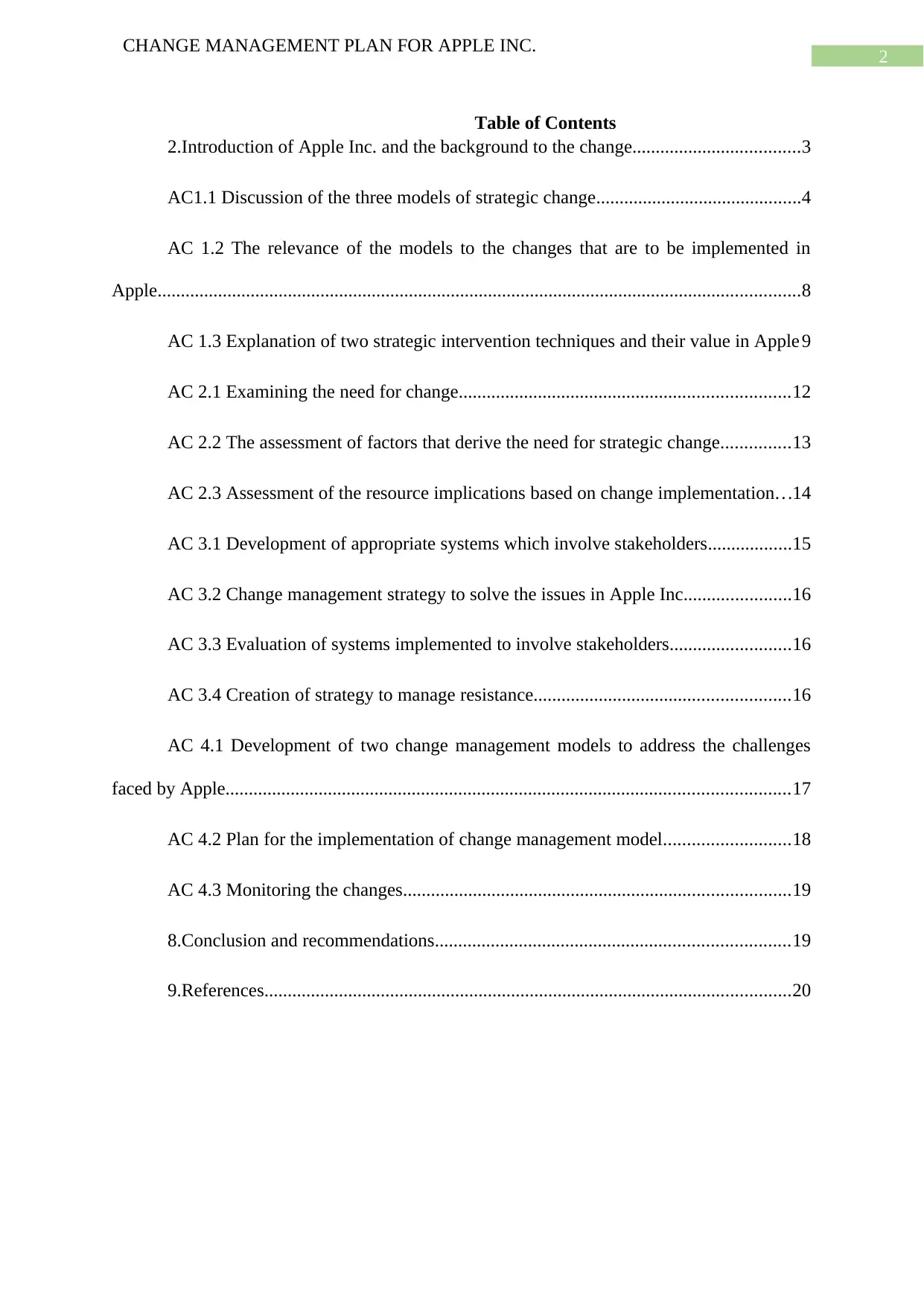
2
CHANGE MANAGEMENT PLAN FOR APPLE INC.
Table of Contents
2.Introduction of Apple Inc. and the background to the change....................................3
AC1.1 Discussion of the three models of strategic change............................................4
AC 1.2 The relevance of the models to the changes that are to be implemented in
Apple..........................................................................................................................................8
AC 1.3 Explanation of two strategic intervention techniques and their value in Apple 9
AC 2.1 Examining the need for change.......................................................................12
AC 2.2 The assessment of factors that derive the need for strategic change...............13
AC 2.3 Assessment of the resource implications based on change implementation...14
AC 3.1 Development of appropriate systems which involve stakeholders..................15
AC 3.2 Change management strategy to solve the issues in Apple Inc.......................16
AC 3.3 Evaluation of systems implemented to involve stakeholders..........................16
AC 3.4 Creation of strategy to manage resistance.......................................................16
AC 4.1 Development of two change management models to address the challenges
faced by Apple.........................................................................................................................17
AC 4.2 Plan for the implementation of change management model...........................18
AC 4.3 Monitoring the changes...................................................................................19
8.Conclusion and recommendations............................................................................19
9.References.................................................................................................................20
CHANGE MANAGEMENT PLAN FOR APPLE INC.
Table of Contents
2.Introduction of Apple Inc. and the background to the change....................................3
AC1.1 Discussion of the three models of strategic change............................................4
AC 1.2 The relevance of the models to the changes that are to be implemented in
Apple..........................................................................................................................................8
AC 1.3 Explanation of two strategic intervention techniques and their value in Apple 9
AC 2.1 Examining the need for change.......................................................................12
AC 2.2 The assessment of factors that derive the need for strategic change...............13
AC 2.3 Assessment of the resource implications based on change implementation...14
AC 3.1 Development of appropriate systems which involve stakeholders..................15
AC 3.2 Change management strategy to solve the issues in Apple Inc.......................16
AC 3.3 Evaluation of systems implemented to involve stakeholders..........................16
AC 3.4 Creation of strategy to manage resistance.......................................................16
AC 4.1 Development of two change management models to address the challenges
faced by Apple.........................................................................................................................17
AC 4.2 Plan for the implementation of change management model...........................18
AC 4.3 Monitoring the changes...................................................................................19
8.Conclusion and recommendations............................................................................19
9.References.................................................................................................................20
⊘ This is a preview!⊘
Do you want full access?
Subscribe today to unlock all pages.

Trusted by 1+ million students worldwide
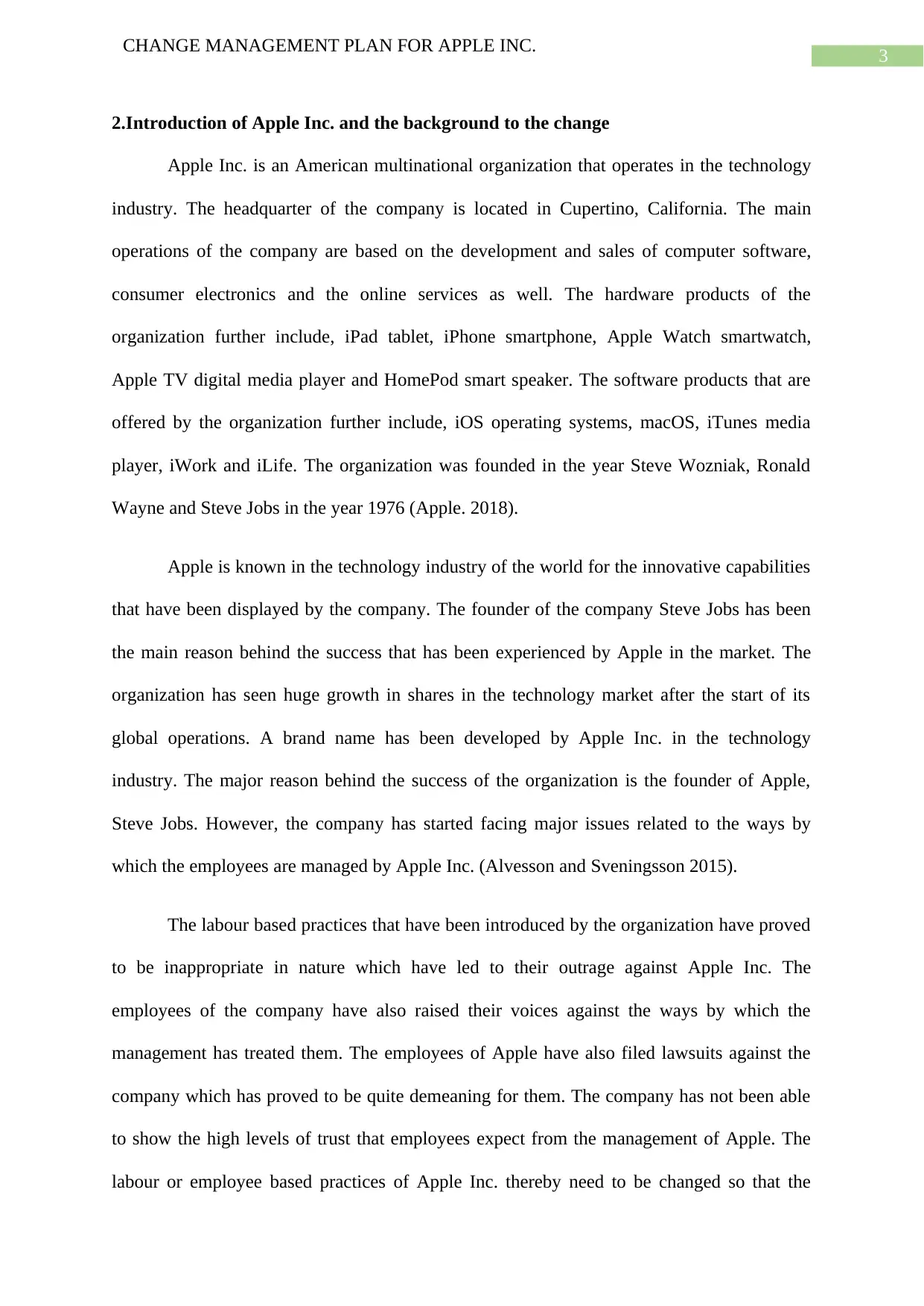
3
CHANGE MANAGEMENT PLAN FOR APPLE INC.
2.Introduction of Apple Inc. and the background to the change
Apple Inc. is an American multinational organization that operates in the technology
industry. The headquarter of the company is located in Cupertino, California. The main
operations of the company are based on the development and sales of computer software,
consumer electronics and the online services as well. The hardware products of the
organization further include, iPad tablet, iPhone smartphone, Apple Watch smartwatch,
Apple TV digital media player and HomePod smart speaker. The software products that are
offered by the organization further include, iOS operating systems, macOS, iTunes media
player, iWork and iLife. The organization was founded in the year Steve Wozniak, Ronald
Wayne and Steve Jobs in the year 1976 (Apple. 2018).
Apple is known in the technology industry of the world for the innovative capabilities
that have been displayed by the company. The founder of the company Steve Jobs has been
the main reason behind the success that has been experienced by Apple in the market. The
organization has seen huge growth in shares in the technology market after the start of its
global operations. A brand name has been developed by Apple Inc. in the technology
industry. The major reason behind the success of the organization is the founder of Apple,
Steve Jobs. However, the company has started facing major issues related to the ways by
which the employees are managed by Apple Inc. (Alvesson and Sveningsson 2015).
The labour based practices that have been introduced by the organization have proved
to be inappropriate in nature which have led to their outrage against Apple Inc. The
employees of the company have also raised their voices against the ways by which the
management has treated them. The employees of Apple have also filed lawsuits against the
company which has proved to be quite demeaning for them. The company has not been able
to show the high levels of trust that employees expect from the management of Apple. The
labour or employee based practices of Apple Inc. thereby need to be changed so that the
CHANGE MANAGEMENT PLAN FOR APPLE INC.
2.Introduction of Apple Inc. and the background to the change
Apple Inc. is an American multinational organization that operates in the technology
industry. The headquarter of the company is located in Cupertino, California. The main
operations of the company are based on the development and sales of computer software,
consumer electronics and the online services as well. The hardware products of the
organization further include, iPad tablet, iPhone smartphone, Apple Watch smartwatch,
Apple TV digital media player and HomePod smart speaker. The software products that are
offered by the organization further include, iOS operating systems, macOS, iTunes media
player, iWork and iLife. The organization was founded in the year Steve Wozniak, Ronald
Wayne and Steve Jobs in the year 1976 (Apple. 2018).
Apple is known in the technology industry of the world for the innovative capabilities
that have been displayed by the company. The founder of the company Steve Jobs has been
the main reason behind the success that has been experienced by Apple in the market. The
organization has seen huge growth in shares in the technology market after the start of its
global operations. A brand name has been developed by Apple Inc. in the technology
industry. The major reason behind the success of the organization is the founder of Apple,
Steve Jobs. However, the company has started facing major issues related to the ways by
which the employees are managed by Apple Inc. (Alvesson and Sveningsson 2015).
The labour based practices that have been introduced by the organization have proved
to be inappropriate in nature which have led to their outrage against Apple Inc. The
employees of the company have also raised their voices against the ways by which the
management has treated them. The employees of Apple have also filed lawsuits against the
company which has proved to be quite demeaning for them. The company has not been able
to show the high levels of trust that employees expect from the management of Apple. The
labour or employee based practices of Apple Inc. thereby need to be changed so that the
Paraphrase This Document
Need a fresh take? Get an instant paraphrase of this document with our AI Paraphraser
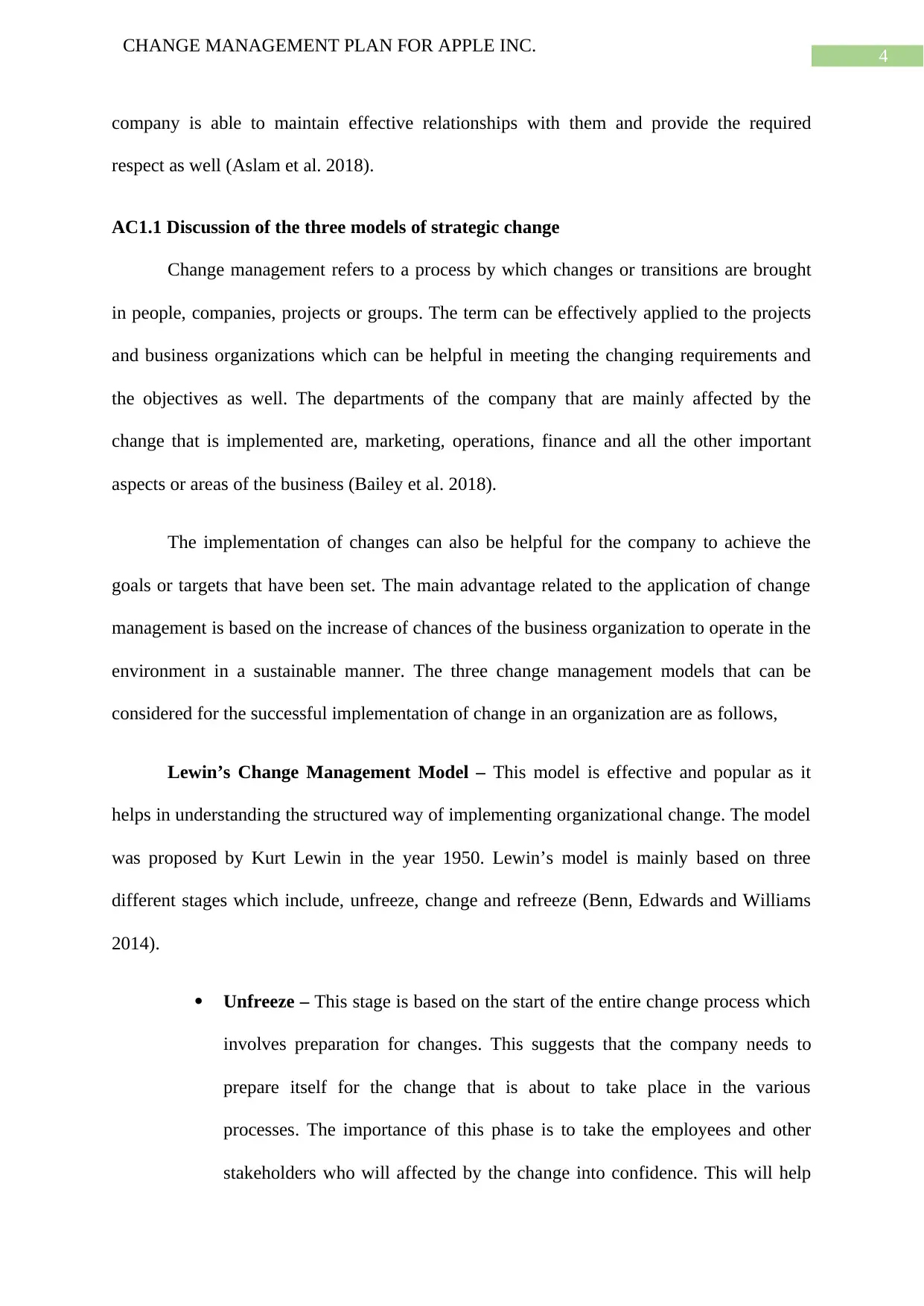
4
CHANGE MANAGEMENT PLAN FOR APPLE INC.
company is able to maintain effective relationships with them and provide the required
respect as well (Aslam et al. 2018).
AC1.1 Discussion of the three models of strategic change
Change management refers to a process by which changes or transitions are brought
in people, companies, projects or groups. The term can be effectively applied to the projects
and business organizations which can be helpful in meeting the changing requirements and
the objectives as well. The departments of the company that are mainly affected by the
change that is implemented are, marketing, operations, finance and all the other important
aspects or areas of the business (Bailey et al. 2018).
The implementation of changes can also be helpful for the company to achieve the
goals or targets that have been set. The main advantage related to the application of change
management is based on the increase of chances of the business organization to operate in the
environment in a sustainable manner. The three change management models that can be
considered for the successful implementation of change in an organization are as follows,
Lewin’s Change Management Model – This model is effective and popular as it
helps in understanding the structured way of implementing organizational change. The model
was proposed by Kurt Lewin in the year 1950. Lewin’s model is mainly based on three
different stages which include, unfreeze, change and refreeze (Benn, Edwards and Williams
2014).
Unfreeze – This stage is based on the start of the entire change process which
involves preparation for changes. This suggests that the company needs to
prepare itself for the change that is about to take place in the various
processes. The importance of this phase is to take the employees and other
stakeholders who will affected by the change into confidence. This will help
CHANGE MANAGEMENT PLAN FOR APPLE INC.
company is able to maintain effective relationships with them and provide the required
respect as well (Aslam et al. 2018).
AC1.1 Discussion of the three models of strategic change
Change management refers to a process by which changes or transitions are brought
in people, companies, projects or groups. The term can be effectively applied to the projects
and business organizations which can be helpful in meeting the changing requirements and
the objectives as well. The departments of the company that are mainly affected by the
change that is implemented are, marketing, operations, finance and all the other important
aspects or areas of the business (Bailey et al. 2018).
The implementation of changes can also be helpful for the company to achieve the
goals or targets that have been set. The main advantage related to the application of change
management is based on the increase of chances of the business organization to operate in the
environment in a sustainable manner. The three change management models that can be
considered for the successful implementation of change in an organization are as follows,
Lewin’s Change Management Model – This model is effective and popular as it
helps in understanding the structured way of implementing organizational change. The model
was proposed by Kurt Lewin in the year 1950. Lewin’s model is mainly based on three
different stages which include, unfreeze, change and refreeze (Benn, Edwards and Williams
2014).
Unfreeze – This stage is based on the start of the entire change process which
involves preparation for changes. This suggests that the company needs to
prepare itself for the change that is about to take place in the various
processes. The importance of this phase is to take the employees and other
stakeholders who will affected by the change into confidence. This will help
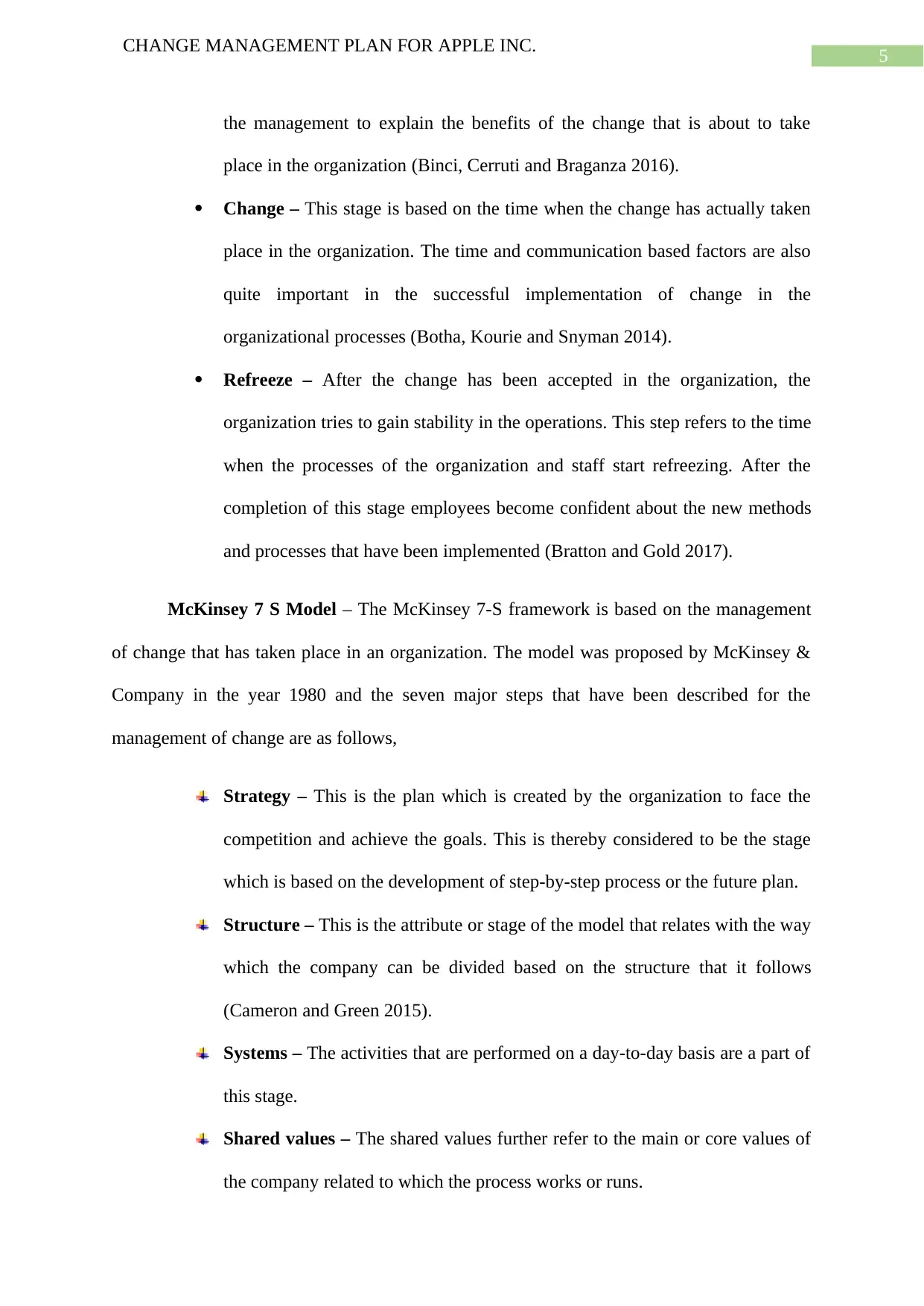
5
CHANGE MANAGEMENT PLAN FOR APPLE INC.
the management to explain the benefits of the change that is about to take
place in the organization (Binci, Cerruti and Braganza 2016).
Change – This stage is based on the time when the change has actually taken
place in the organization. The time and communication based factors are also
quite important in the successful implementation of change in the
organizational processes (Botha, Kourie and Snyman 2014).
Refreeze – After the change has been accepted in the organization, the
organization tries to gain stability in the operations. This step refers to the time
when the processes of the organization and staff start refreezing. After the
completion of this stage employees become confident about the new methods
and processes that have been implemented (Bratton and Gold 2017).
McKinsey 7 S Model – The McKinsey 7-S framework is based on the management
of change that has taken place in an organization. The model was proposed by McKinsey &
Company in the year 1980 and the seven major steps that have been described for the
management of change are as follows,
Strategy – This is the plan which is created by the organization to face the
competition and achieve the goals. This is thereby considered to be the stage
which is based on the development of step-by-step process or the future plan.
Structure – This is the attribute or stage of the model that relates with the way
which the company can be divided based on the structure that it follows
(Cameron and Green 2015).
Systems – The activities that are performed on a day-to-day basis are a part of
this stage.
Shared values – The shared values further refer to the main or core values of
the company related to which the process works or runs.
CHANGE MANAGEMENT PLAN FOR APPLE INC.
the management to explain the benefits of the change that is about to take
place in the organization (Binci, Cerruti and Braganza 2016).
Change – This stage is based on the time when the change has actually taken
place in the organization. The time and communication based factors are also
quite important in the successful implementation of change in the
organizational processes (Botha, Kourie and Snyman 2014).
Refreeze – After the change has been accepted in the organization, the
organization tries to gain stability in the operations. This step refers to the time
when the processes of the organization and staff start refreezing. After the
completion of this stage employees become confident about the new methods
and processes that have been implemented (Bratton and Gold 2017).
McKinsey 7 S Model – The McKinsey 7-S framework is based on the management
of change that has taken place in an organization. The model was proposed by McKinsey &
Company in the year 1980 and the seven major steps that have been described for the
management of change are as follows,
Strategy – This is the plan which is created by the organization to face the
competition and achieve the goals. This is thereby considered to be the stage
which is based on the development of step-by-step process or the future plan.
Structure – This is the attribute or stage of the model that relates with the way
which the company can be divided based on the structure that it follows
(Cameron and Green 2015).
Systems – The activities that are performed on a day-to-day basis are a part of
this stage.
Shared values – The shared values further refer to the main or core values of
the company related to which the process works or runs.
⊘ This is a preview!⊘
Do you want full access?
Subscribe today to unlock all pages.

Trusted by 1+ million students worldwide
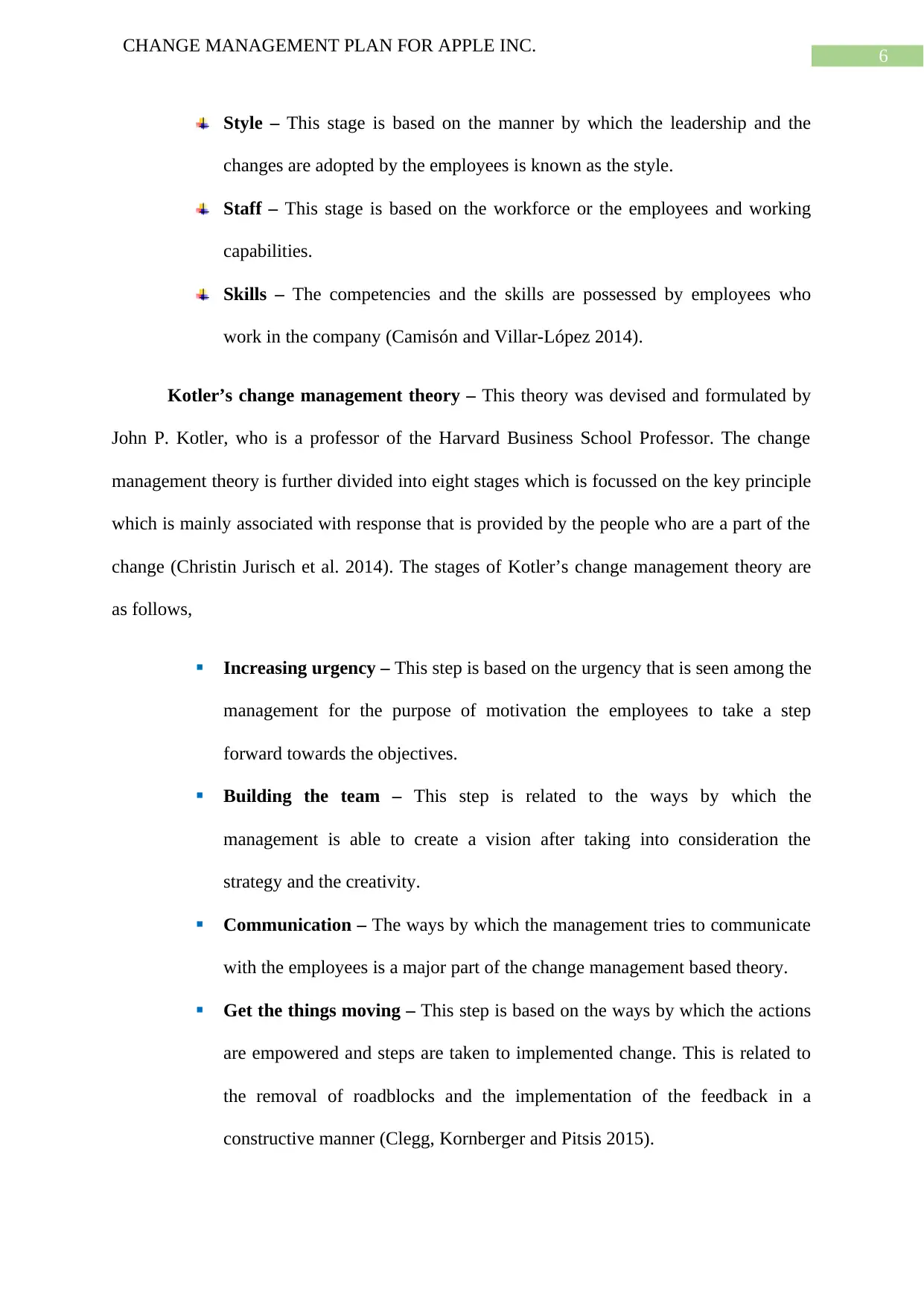
6
CHANGE MANAGEMENT PLAN FOR APPLE INC.
Style – This stage is based on the manner by which the leadership and the
changes are adopted by the employees is known as the style.
Staff – This stage is based on the workforce or the employees and working
capabilities.
Skills – The competencies and the skills are possessed by employees who
work in the company (Camisón and Villar-López 2014).
Kotler’s change management theory – This theory was devised and formulated by
John P. Kotler, who is a professor of the Harvard Business School Professor. The change
management theory is further divided into eight stages which is focussed on the key principle
which is mainly associated with response that is provided by the people who are a part of the
change (Christin Jurisch et al. 2014). The stages of Kotler’s change management theory are
as follows,
Increasing urgency – This step is based on the urgency that is seen among the
management for the purpose of motivation the employees to take a step
forward towards the objectives.
Building the team – This step is related to the ways by which the
management is able to create a vision after taking into consideration the
strategy and the creativity.
Communication – The ways by which the management tries to communicate
with the employees is a major part of the change management based theory.
Get the things moving – This step is based on the ways by which the actions
are empowered and steps are taken to implemented change. This is related to
the removal of roadblocks and the implementation of the feedback in a
constructive manner (Clegg, Kornberger and Pitsis 2015).
CHANGE MANAGEMENT PLAN FOR APPLE INC.
Style – This stage is based on the manner by which the leadership and the
changes are adopted by the employees is known as the style.
Staff – This stage is based on the workforce or the employees and working
capabilities.
Skills – The competencies and the skills are possessed by employees who
work in the company (Camisón and Villar-López 2014).
Kotler’s change management theory – This theory was devised and formulated by
John P. Kotler, who is a professor of the Harvard Business School Professor. The change
management theory is further divided into eight stages which is focussed on the key principle
which is mainly associated with response that is provided by the people who are a part of the
change (Christin Jurisch et al. 2014). The stages of Kotler’s change management theory are
as follows,
Increasing urgency – This step is based on the urgency that is seen among the
management for the purpose of motivation the employees to take a step
forward towards the objectives.
Building the team – This step is related to the ways by which the
management is able to create a vision after taking into consideration the
strategy and the creativity.
Communication – The ways by which the management tries to communicate
with the employees is a major part of the change management based theory.
Get the things moving – This step is based on the ways by which the actions
are empowered and steps are taken to implemented change. This is related to
the removal of roadblocks and the implementation of the feedback in a
constructive manner (Clegg, Kornberger and Pitsis 2015).
Paraphrase This Document
Need a fresh take? Get an instant paraphrase of this document with our AI Paraphraser
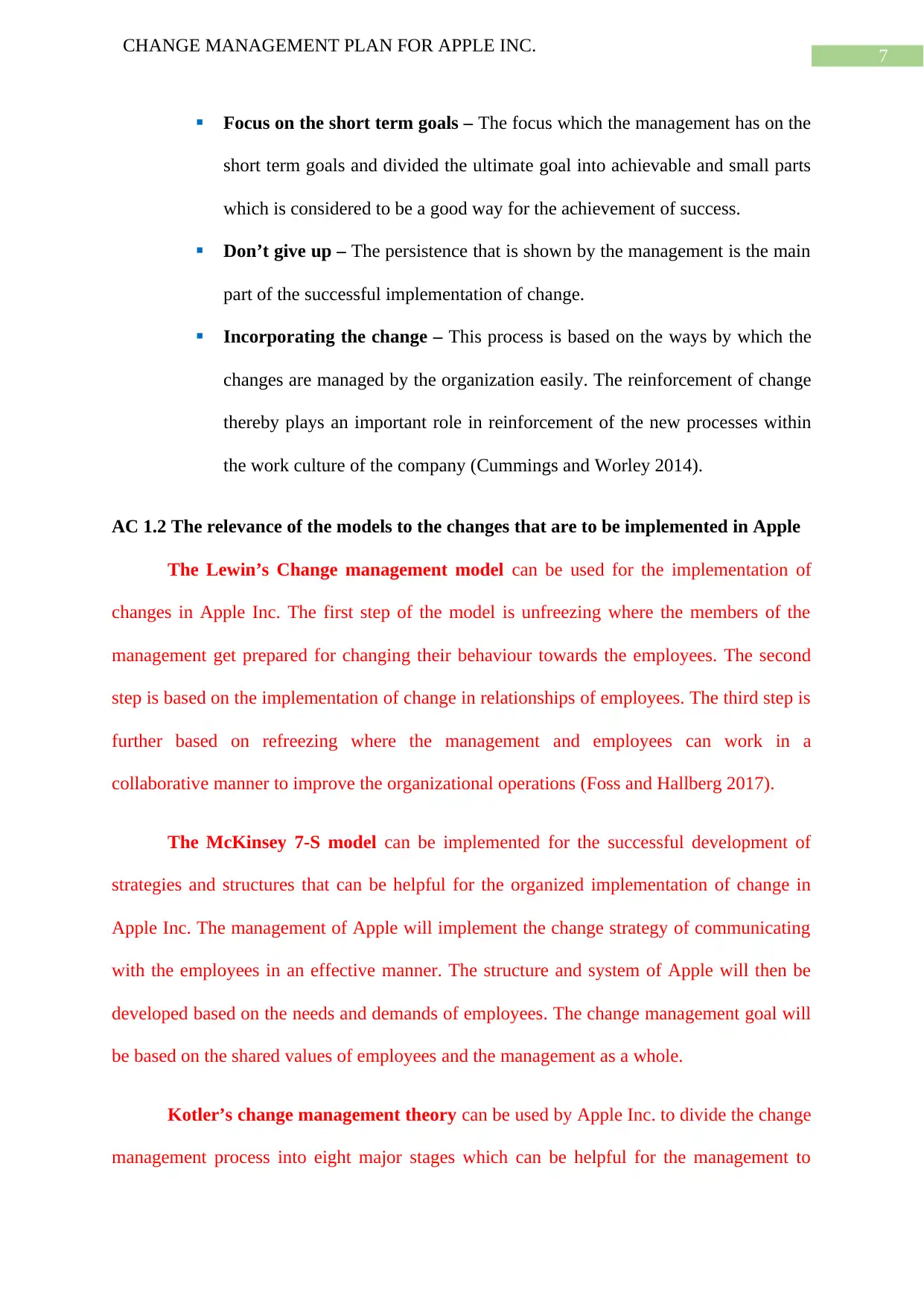
7
CHANGE MANAGEMENT PLAN FOR APPLE INC.
Focus on the short term goals – The focus which the management has on the
short term goals and divided the ultimate goal into achievable and small parts
which is considered to be a good way for the achievement of success.
Don’t give up – The persistence that is shown by the management is the main
part of the successful implementation of change.
Incorporating the change – This process is based on the ways by which the
changes are managed by the organization easily. The reinforcement of change
thereby plays an important role in reinforcement of the new processes within
the work culture of the company (Cummings and Worley 2014).
AC 1.2 The relevance of the models to the changes that are to be implemented in Apple
The Lewin’s Change management model can be used for the implementation of
changes in Apple Inc. The first step of the model is unfreezing where the members of the
management get prepared for changing their behaviour towards the employees. The second
step is based on the implementation of change in relationships of employees. The third step is
further based on refreezing where the management and employees can work in a
collaborative manner to improve the organizational operations (Foss and Hallberg 2017).
The McKinsey 7-S model can be implemented for the successful development of
strategies and structures that can be helpful for the organized implementation of change in
Apple Inc. The management of Apple will implement the change strategy of communicating
with the employees in an effective manner. The structure and system of Apple will then be
developed based on the needs and demands of employees. The change management goal will
be based on the shared values of employees and the management as a whole.
Kotler’s change management theory can be used by Apple Inc. to divide the change
management process into eight major stages which can be helpful for the management to
CHANGE MANAGEMENT PLAN FOR APPLE INC.
Focus on the short term goals – The focus which the management has on the
short term goals and divided the ultimate goal into achievable and small parts
which is considered to be a good way for the achievement of success.
Don’t give up – The persistence that is shown by the management is the main
part of the successful implementation of change.
Incorporating the change – This process is based on the ways by which the
changes are managed by the organization easily. The reinforcement of change
thereby plays an important role in reinforcement of the new processes within
the work culture of the company (Cummings and Worley 2014).
AC 1.2 The relevance of the models to the changes that are to be implemented in Apple
The Lewin’s Change management model can be used for the implementation of
changes in Apple Inc. The first step of the model is unfreezing where the members of the
management get prepared for changing their behaviour towards the employees. The second
step is based on the implementation of change in relationships of employees. The third step is
further based on refreezing where the management and employees can work in a
collaborative manner to improve the organizational operations (Foss and Hallberg 2017).
The McKinsey 7-S model can be implemented for the successful development of
strategies and structures that can be helpful for the organized implementation of change in
Apple Inc. The management of Apple will implement the change strategy of communicating
with the employees in an effective manner. The structure and system of Apple will then be
developed based on the needs and demands of employees. The change management goal will
be based on the shared values of employees and the management as a whole.
Kotler’s change management theory can be used by Apple Inc. to divide the change
management process into eight major stages which can be helpful for the management to
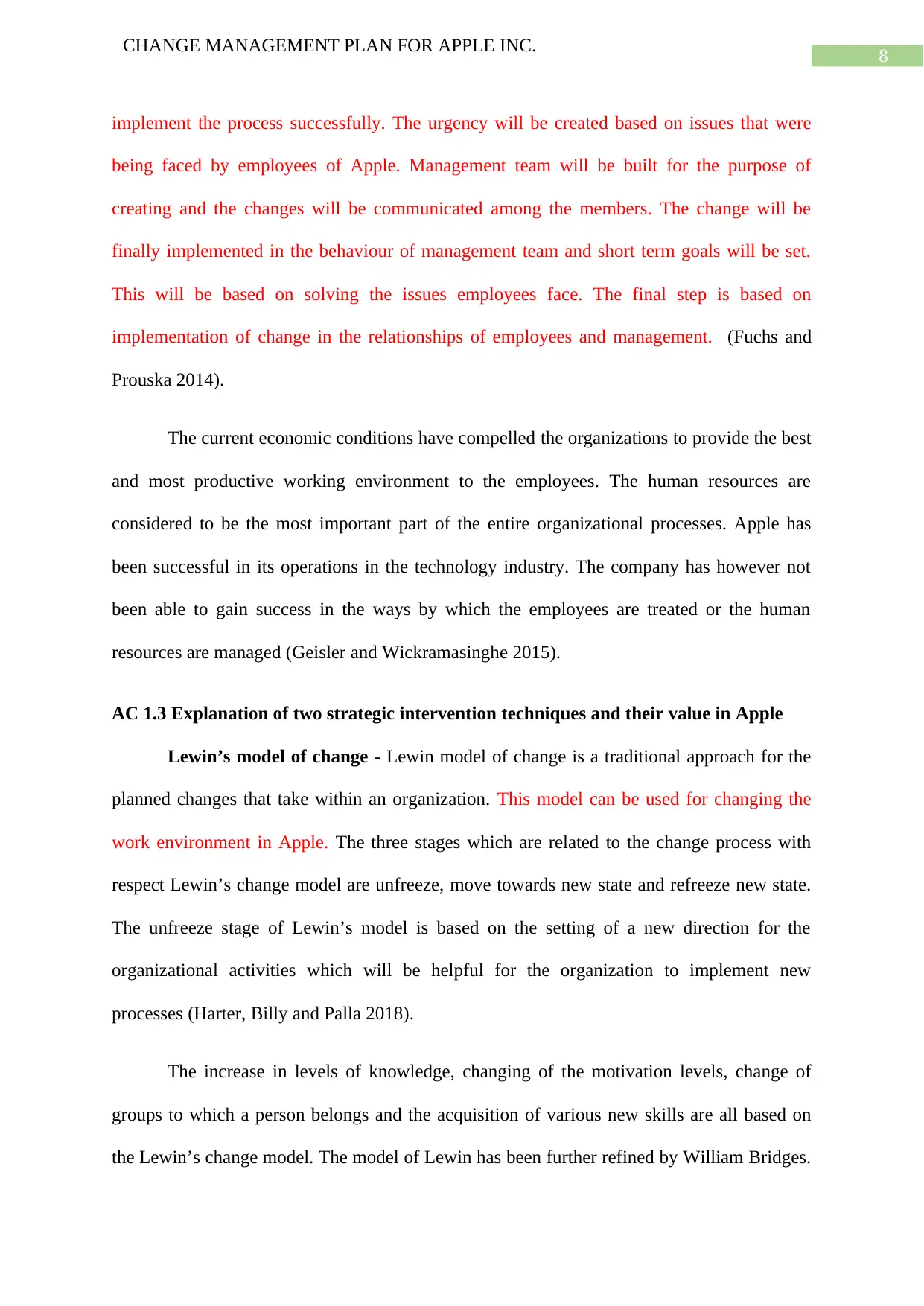
8
CHANGE MANAGEMENT PLAN FOR APPLE INC.
implement the process successfully. The urgency will be created based on issues that were
being faced by employees of Apple. Management team will be built for the purpose of
creating and the changes will be communicated among the members. The change will be
finally implemented in the behaviour of management team and short term goals will be set.
This will be based on solving the issues employees face. The final step is based on
implementation of change in the relationships of employees and management. (Fuchs and
Prouska 2014).
The current economic conditions have compelled the organizations to provide the best
and most productive working environment to the employees. The human resources are
considered to be the most important part of the entire organizational processes. Apple has
been successful in its operations in the technology industry. The company has however not
been able to gain success in the ways by which the employees are treated or the human
resources are managed (Geisler and Wickramasinghe 2015).
AC 1.3 Explanation of two strategic intervention techniques and their value in Apple
Lewin’s model of change - Lewin model of change is a traditional approach for the
planned changes that take within an organization. This model can be used for changing the
work environment in Apple. The three stages which are related to the change process with
respect Lewin’s change model are unfreeze, move towards new state and refreeze new state.
The unfreeze stage of Lewin’s model is based on the setting of a new direction for the
organizational activities which will be helpful for the organization to implement new
processes (Harter, Billy and Palla 2018).
The increase in levels of knowledge, changing of the motivation levels, change of
groups to which a person belongs and the acquisition of various new skills are all based on
the Lewin’s change model. The model of Lewin has been further refined by William Bridges.
CHANGE MANAGEMENT PLAN FOR APPLE INC.
implement the process successfully. The urgency will be created based on issues that were
being faced by employees of Apple. Management team will be built for the purpose of
creating and the changes will be communicated among the members. The change will be
finally implemented in the behaviour of management team and short term goals will be set.
This will be based on solving the issues employees face. The final step is based on
implementation of change in the relationships of employees and management. (Fuchs and
Prouska 2014).
The current economic conditions have compelled the organizations to provide the best
and most productive working environment to the employees. The human resources are
considered to be the most important part of the entire organizational processes. Apple has
been successful in its operations in the technology industry. The company has however not
been able to gain success in the ways by which the employees are treated or the human
resources are managed (Geisler and Wickramasinghe 2015).
AC 1.3 Explanation of two strategic intervention techniques and their value in Apple
Lewin’s model of change - Lewin model of change is a traditional approach for the
planned changes that take within an organization. This model can be used for changing the
work environment in Apple. The three stages which are related to the change process with
respect Lewin’s change model are unfreeze, move towards new state and refreeze new state.
The unfreeze stage of Lewin’s model is based on the setting of a new direction for the
organizational activities which will be helpful for the organization to implement new
processes (Harter, Billy and Palla 2018).
The increase in levels of knowledge, changing of the motivation levels, change of
groups to which a person belongs and the acquisition of various new skills are all based on
the Lewin’s change model. The model of Lewin has been further refined by William Bridges.
⊘ This is a preview!⊘
Do you want full access?
Subscribe today to unlock all pages.

Trusted by 1+ million students worldwide
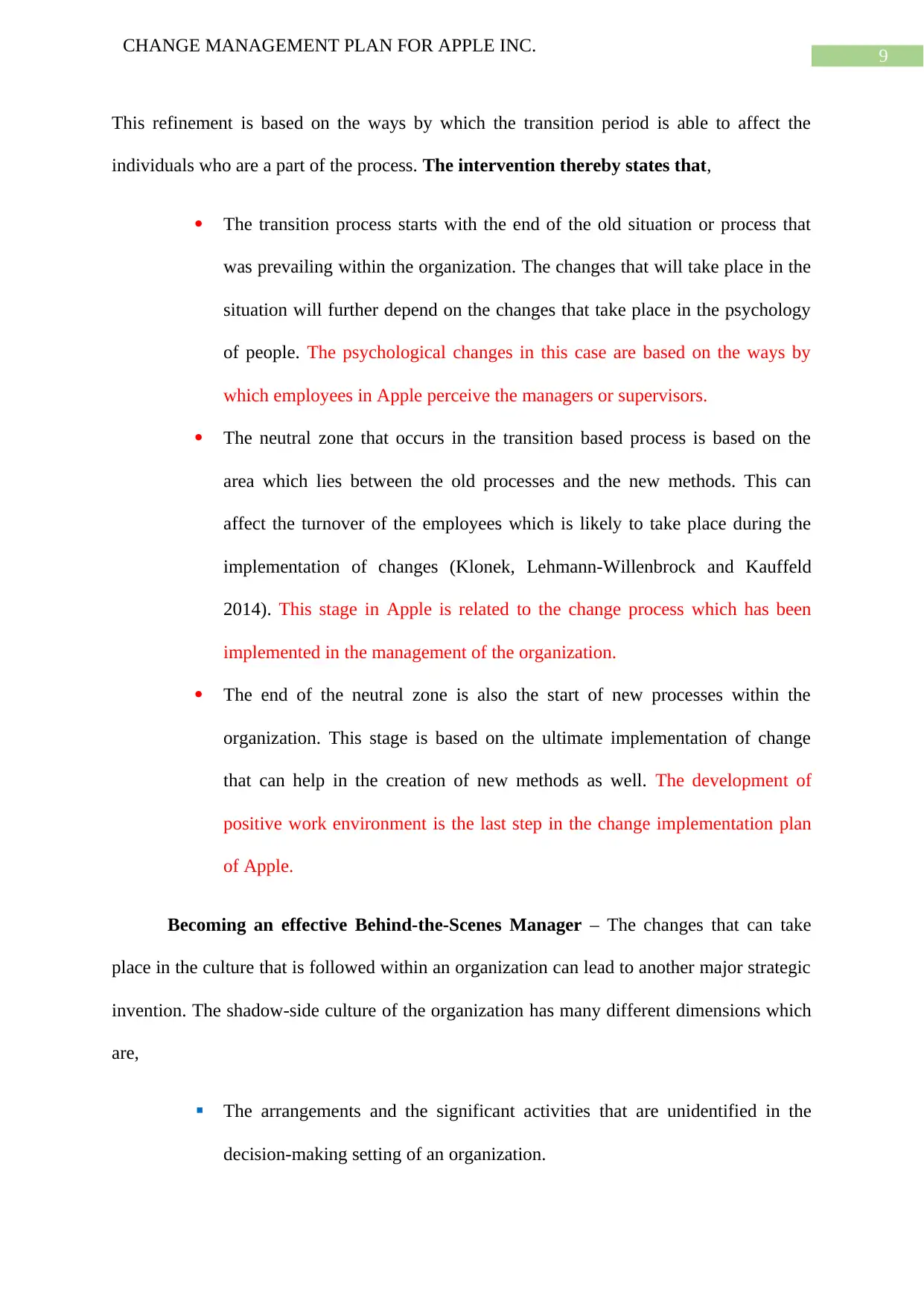
9
CHANGE MANAGEMENT PLAN FOR APPLE INC.
This refinement is based on the ways by which the transition period is able to affect the
individuals who are a part of the process. The intervention thereby states that,
The transition process starts with the end of the old situation or process that
was prevailing within the organization. The changes that will take place in the
situation will further depend on the changes that take place in the psychology
of people. The psychological changes in this case are based on the ways by
which employees in Apple perceive the managers or supervisors.
The neutral zone that occurs in the transition based process is based on the
area which lies between the old processes and the new methods. This can
affect the turnover of the employees which is likely to take place during the
implementation of changes (Klonek, Lehmann-Willenbrock and Kauffeld
2014). This stage in Apple is related to the change process which has been
implemented in the management of the organization.
The end of the neutral zone is also the start of new processes within the
organization. This stage is based on the ultimate implementation of change
that can help in the creation of new methods as well. The development of
positive work environment is the last step in the change implementation plan
of Apple.
Becoming an effective Behind-the-Scenes Manager – The changes that can take
place in the culture that is followed within an organization can lead to another major strategic
invention. The shadow-side culture of the organization has many different dimensions which
are,
The arrangements and the significant activities that are unidentified in the
decision-making setting of an organization.
CHANGE MANAGEMENT PLAN FOR APPLE INC.
This refinement is based on the ways by which the transition period is able to affect the
individuals who are a part of the process. The intervention thereby states that,
The transition process starts with the end of the old situation or process that
was prevailing within the organization. The changes that will take place in the
situation will further depend on the changes that take place in the psychology
of people. The psychological changes in this case are based on the ways by
which employees in Apple perceive the managers or supervisors.
The neutral zone that occurs in the transition based process is based on the
area which lies between the old processes and the new methods. This can
affect the turnover of the employees which is likely to take place during the
implementation of changes (Klonek, Lehmann-Willenbrock and Kauffeld
2014). This stage in Apple is related to the change process which has been
implemented in the management of the organization.
The end of the neutral zone is also the start of new processes within the
organization. This stage is based on the ultimate implementation of change
that can help in the creation of new methods as well. The development of
positive work environment is the last step in the change implementation plan
of Apple.
Becoming an effective Behind-the-Scenes Manager – The changes that can take
place in the culture that is followed within an organization can lead to another major strategic
invention. The shadow-side culture of the organization has many different dimensions which
are,
The arrangements and the significant activities that are unidentified in the
decision-making setting of an organization.
Paraphrase This Document
Need a fresh take? Get an instant paraphrase of this document with our AI Paraphraser
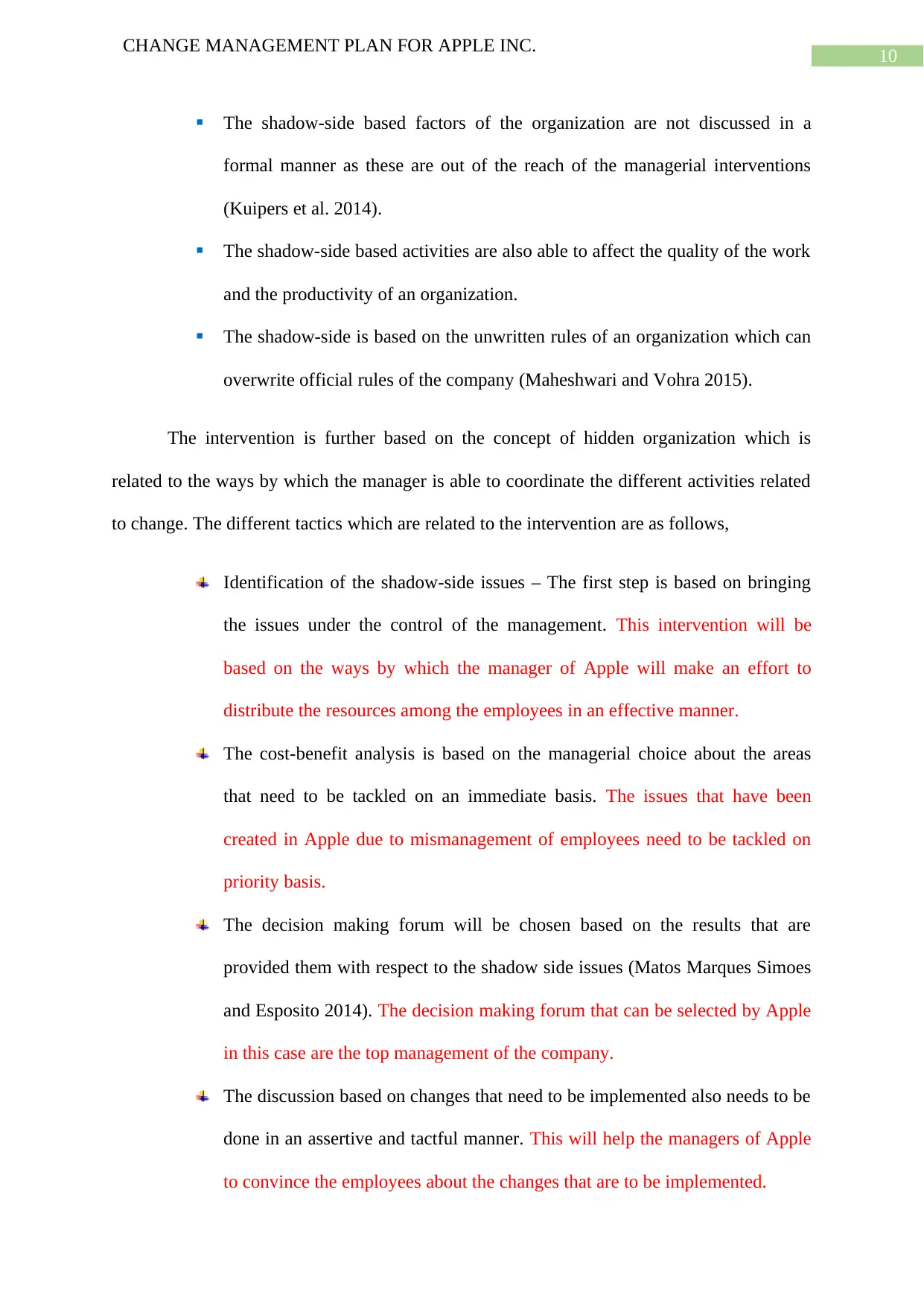
10
CHANGE MANAGEMENT PLAN FOR APPLE INC.
The shadow-side based factors of the organization are not discussed in a
formal manner as these are out of the reach of the managerial interventions
(Kuipers et al. 2014).
The shadow-side based activities are also able to affect the quality of the work
and the productivity of an organization.
The shadow-side is based on the unwritten rules of an organization which can
overwrite official rules of the company (Maheshwari and Vohra 2015).
The intervention is further based on the concept of hidden organization which is
related to the ways by which the manager is able to coordinate the different activities related
to change. The different tactics which are related to the intervention are as follows,
Identification of the shadow-side issues – The first step is based on bringing
the issues under the control of the management. This intervention will be
based on the ways by which the manager of Apple will make an effort to
distribute the resources among the employees in an effective manner.
The cost-benefit analysis is based on the managerial choice about the areas
that need to be tackled on an immediate basis. The issues that have been
created in Apple due to mismanagement of employees need to be tackled on
priority basis.
The decision making forum will be chosen based on the results that are
provided them with respect to the shadow side issues (Matos Marques Simoes
and Esposito 2014). The decision making forum that can be selected by Apple
in this case are the top management of the company.
The discussion based on changes that need to be implemented also needs to be
done in an assertive and tactful manner. This will help the managers of Apple
to convince the employees about the changes that are to be implemented.
CHANGE MANAGEMENT PLAN FOR APPLE INC.
The shadow-side based factors of the organization are not discussed in a
formal manner as these are out of the reach of the managerial interventions
(Kuipers et al. 2014).
The shadow-side based activities are also able to affect the quality of the work
and the productivity of an organization.
The shadow-side is based on the unwritten rules of an organization which can
overwrite official rules of the company (Maheshwari and Vohra 2015).
The intervention is further based on the concept of hidden organization which is
related to the ways by which the manager is able to coordinate the different activities related
to change. The different tactics which are related to the intervention are as follows,
Identification of the shadow-side issues – The first step is based on bringing
the issues under the control of the management. This intervention will be
based on the ways by which the manager of Apple will make an effort to
distribute the resources among the employees in an effective manner.
The cost-benefit analysis is based on the managerial choice about the areas
that need to be tackled on an immediate basis. The issues that have been
created in Apple due to mismanagement of employees need to be tackled on
priority basis.
The decision making forum will be chosen based on the results that are
provided them with respect to the shadow side issues (Matos Marques Simoes
and Esposito 2014). The decision making forum that can be selected by Apple
in this case are the top management of the company.
The discussion based on changes that need to be implemented also needs to be
done in an assertive and tactful manner. This will help the managers of Apple
to convince the employees about the changes that are to be implemented.
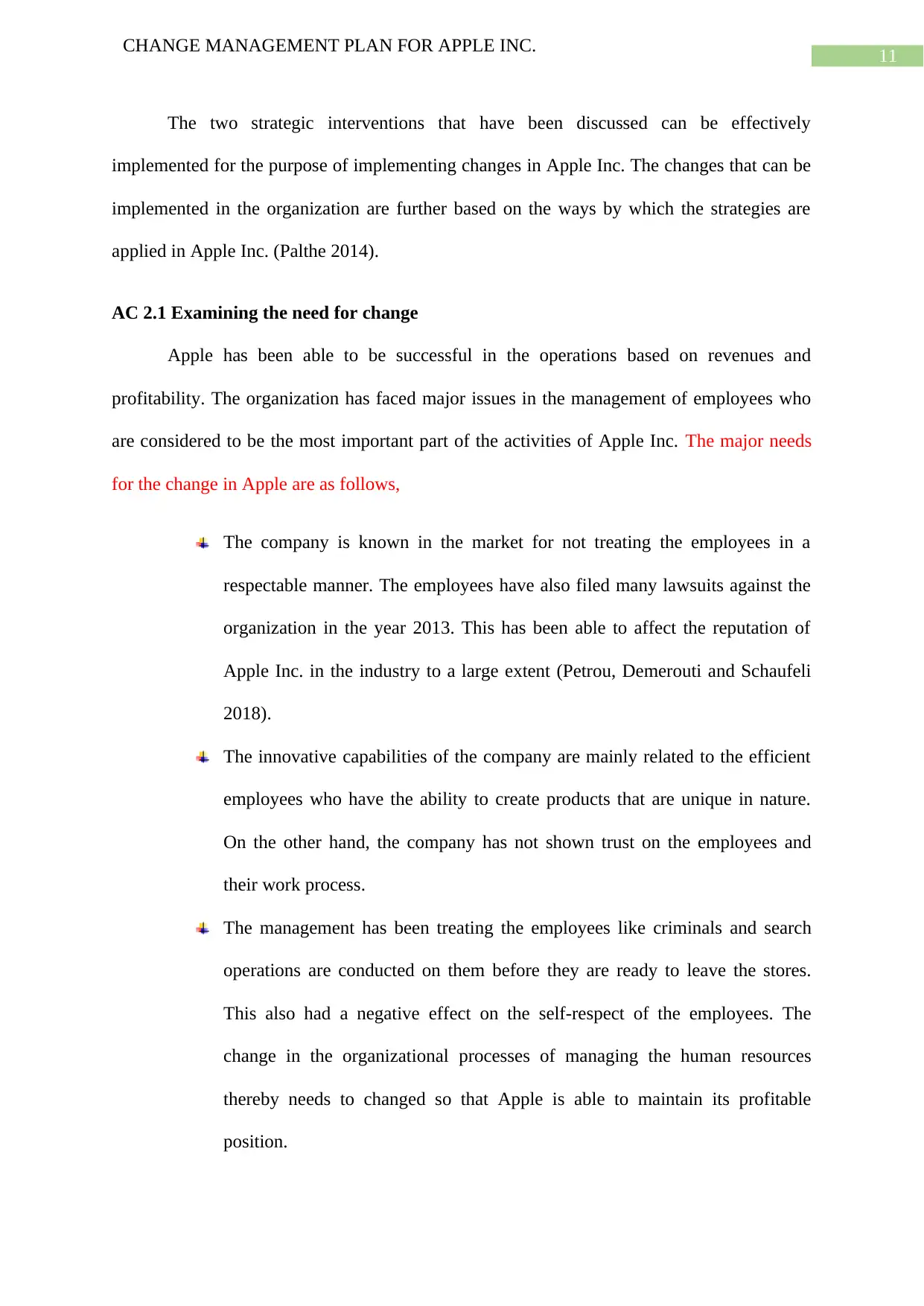
11
CHANGE MANAGEMENT PLAN FOR APPLE INC.
The two strategic interventions that have been discussed can be effectively
implemented for the purpose of implementing changes in Apple Inc. The changes that can be
implemented in the organization are further based on the ways by which the strategies are
applied in Apple Inc. (Palthe 2014).
AC 2.1 Examining the need for change
Apple has been able to be successful in the operations based on revenues and
profitability. The organization has faced major issues in the management of employees who
are considered to be the most important part of the activities of Apple Inc. The major needs
for the change in Apple are as follows,
The company is known in the market for not treating the employees in a
respectable manner. The employees have also filed many lawsuits against the
organization in the year 2013. This has been able to affect the reputation of
Apple Inc. in the industry to a large extent (Petrou, Demerouti and Schaufeli
2018).
The innovative capabilities of the company are mainly related to the efficient
employees who have the ability to create products that are unique in nature.
On the other hand, the company has not shown trust on the employees and
their work process.
The management has been treating the employees like criminals and search
operations are conducted on them before they are ready to leave the stores.
This also had a negative effect on the self-respect of the employees. The
change in the organizational processes of managing the human resources
thereby needs to changed so that Apple is able to maintain its profitable
position.
CHANGE MANAGEMENT PLAN FOR APPLE INC.
The two strategic interventions that have been discussed can be effectively
implemented for the purpose of implementing changes in Apple Inc. The changes that can be
implemented in the organization are further based on the ways by which the strategies are
applied in Apple Inc. (Palthe 2014).
AC 2.1 Examining the need for change
Apple has been able to be successful in the operations based on revenues and
profitability. The organization has faced major issues in the management of employees who
are considered to be the most important part of the activities of Apple Inc. The major needs
for the change in Apple are as follows,
The company is known in the market for not treating the employees in a
respectable manner. The employees have also filed many lawsuits against the
organization in the year 2013. This has been able to affect the reputation of
Apple Inc. in the industry to a large extent (Petrou, Demerouti and Schaufeli
2018).
The innovative capabilities of the company are mainly related to the efficient
employees who have the ability to create products that are unique in nature.
On the other hand, the company has not shown trust on the employees and
their work process.
The management has been treating the employees like criminals and search
operations are conducted on them before they are ready to leave the stores.
This also had a negative effect on the self-respect of the employees. The
change in the organizational processes of managing the human resources
thereby needs to changed so that Apple is able to maintain its profitable
position.
⊘ This is a preview!⊘
Do you want full access?
Subscribe today to unlock all pages.

Trusted by 1+ million students worldwide
1 out of 22
Related Documents
Your All-in-One AI-Powered Toolkit for Academic Success.
+13062052269
info@desklib.com
Available 24*7 on WhatsApp / Email
![[object Object]](/_next/static/media/star-bottom.7253800d.svg)
Unlock your academic potential
Copyright © 2020–2025 A2Z Services. All Rights Reserved. Developed and managed by ZUCOL.




